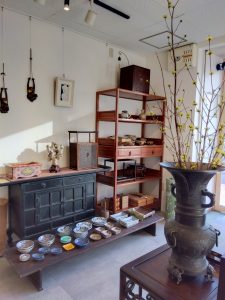「真・行・草」(愛知県名古屋市千種区姫池通 骨董買取 古美術風光舎)
2025.01.21
今日の名古屋はポカポカ陽気です。寒さが和らぐのは大歓迎なのですが、花粉が早めに飛び出す予報が…。ちょっと早くないですか。もっと遅くていいんですが…。
さて、外気の暖かさもあってか、店内に飾ってありますサンシュユが花開きました。サンシュユという独特な響きですが、中国植物名「山茱萸」を音読みしたものを和名としたためのようです。別名『ハルコガネバナ(春黄金花)』と言うのだそう。
春には黄色い花を咲かせ、秋にはサンゴのようにつややかな赤い実が楽しめるのだそう。実は食べられるようですが、生では渋みが強く、ジャムや果実酒で味わうことが出来るそうです。日本には、江戸時代にもともと薬用として持ち込まれており、滋養強壮や疲労回復など健康酒としても飲まれていたのだとか。

そんな華やかな枝とともに、目に入ってきますのが銅の花入です。
茶道において、茶室に生けられる花には重要な役割があるとされ、その花を演出するのに欠かせないのが、花を入れる容器である花入れです。
古銅花入は茶道において「真・行・草」の中の「真」の花入とされています。材質によりに分けられ、「真」は古銅、唐物青磁。「行」は釉薬のかかった和物の陶磁器。「草」は竹、籠、瓢、釉薬をつけていない陶磁器などとなります。茶事や掛軸、他の道具との取り合わせなどにより使用する花器が選ばれました。
「真・行・草」とは、茶道や華道などで格式を分ける考え方で、真が最も格が高く、以下に行、草と続きます。書道でも同じく「楷書」「行書」「草書」と格分けされているので、こちらの方がピンとくる方もいるかもしれません。
真・行・草は書道で使われる三つの筆法。楷書のことを真書と呼び、崩した行書、さらに崩した草書の三つ筆法を意味します。これが転じて茶道・華道・俳諧・庭園などにも、この真・行・草の構成が見られ、建築様式のなかでも特に和室の格式の表現形式として用いられています。
ちなみに漢字の成り立ちは、ご存知の方も多いと思いますが、篆書(てんしょ)、次に隷書(れいしょ)が生まれ、そこから草書・行書・楷書が生まれました。実は、一番最後に誕生したのが楷書になるのですが、書道を習うときは、この逆の順で習います。
成り立ちを知れば分かることなのですが、草書は隷書を早書きするために生まれた書体です。ですので、草書は楷書を崩したわけではありません。そのため、字形の関連性が無い文字がたくさんあります。
昔、草書を勉強した時に、草書は外国語と同じだなと思ったのも至極当然のことなのでした。
ではでは、また。(スタッフT)
It is a warm and sunny day in Nagoya today. The easing of the cold weather is very welcome, but the pollen is forecast to start flying out early…. Isn’t it a little early? It could be later, but….
The sanshouyu (Japanese sand daisy) that is on display in the store has blossomed, probably due to the warmth of the outside air. The name “sanshuyu” sounds peculiar, but it seems to be a Japanese name derived from the Chinese botanical name “sanshuyu” (山茱萸), which is read phonetically. It is also known as “harukogane bana (spring golden flower).
In spring, it produces yellow flowers, and in autumn, we can enjoy its coral-like glossy red berries. The berries are edible, but they are too astringent to eat raw, so they can be enjoyed with jam or fruit wine. It was originally brought to Japan in the Edo period (1603-1867) for medicinal purposes, and was also drunk as a health tonic and to relieve fatigue.
Along with these gorgeous branches, you may also notice the copper vase.
In the tea ceremony, flowers arranged in the tea room play an important role, and the flower vase, the container for the flowers, is indispensable to presenting the flowers.
In the tea ceremony, kodo hanabi vases are considered to be the “true” hanabi vases among the “true,” “action,” and “grass” vases. The “true” type is made of old copper and Chinese celadon, while the “flowing” type is made of glazed porcelain. Gyo” is glazed Japanese ceramics. Kusa” is bamboo, baskets, gourds, and unglazed ceramics. Vases were selected for use in tea ceremonies, hanging scrolls, and in combination with other utensils.
Shin, Gyo, Kusa” is a classification system for tea ceremony and flower arrangement, with ‘Shin’ being the highest grade, followed by Gyo and Kusa. In calligraphy, the same division of rank is used for “kaisho,” “gyosho,” and “sosho,” so this may be more familiar to some people.
Shin, gyō, and sō are the three brush strokes used in calligraphy. Kai-sho is called shin-sho, which means “block style,” and gyosho, which is broken down, and sosho, which is further broken down, meaning three brush strokes. The three strokes are used in tea ceremony, flower arrangement, haikai, gardens, etc., and are also used as a form of expressing the prestige of a Japanese room, especially in architectural styles.
As many of you may know, the Chinese characters were first written in seal script (tensho), then in clerical script (reisho), followed by cursive script (sosho), line script (gyosho), and standard script (kaisho). In fact, the last to be born was the standard style, but when you learn calligraphy, you learn them in the reverse order.
If you know the origin of cursive script, you will understand that cursive script was created in order to write clerical script faster. Therefore, cursive is not a corruption of the standard style. Therefore, there are many characters that are not related to each other in character form.
When I studied cursive in the past, it was quite natural that I thought cursive was like a foreign language.
See you soon. (Staff T)
*******************
ご実家の整理やお片付けなどをされている方のご相談などが多くございます。
お片付けなどくれぐれもご無理のないようになさってくださいませ。
風光舎では古美術品や骨董品の他にも絵画や宝石、趣味のお品など様々なジャンルのものを買受しております。
お片付けをされていて、こういうものでもいいのかしらと迷われているものでも、どうぞお気軽にご相談下さいませ。
また風光舎は、出張買取も強化しております。ご近所はもちろん、愛知県内、岐阜県、三重県その他の県へも出張いたします。
まずは、お電話お待ちしております。
愛知県名古屋市千種区姫池通
骨董 買取【古美術 風光舎 名古屋店】
TEL052(734)8444
10:00-18:00 OPEN
#出張買取#骨董#古美術#骨董品#絵画#版画#茶道具#刀剣#彫刻

